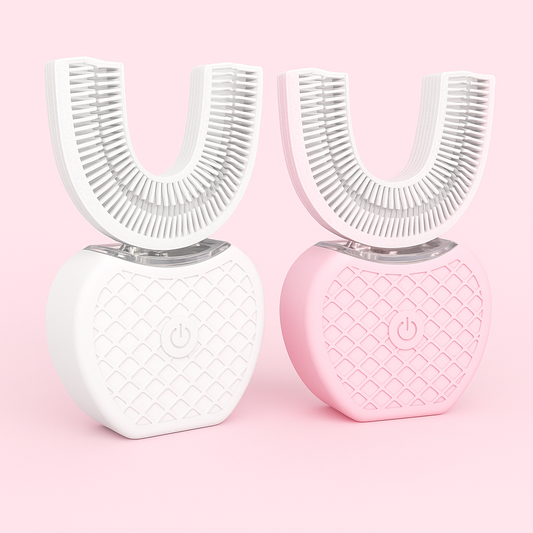Introduction
More consumers are choosing fluoride-free oral care while still wanting noticeable whitening results. Whether you want to avoid fluoride for personal reasons, sensitivity, or because you prefer alternative actives, modern fluoride-free toothpaste formulas now include ingredients such as niacinamide and xylitol that support gum health and bacterial balance while offering stain-lifting performance.
This extended buyer's checklist will help you understand how whitening works, which ingredients matter, how to evaluate abrasivity and safety, and how to choose an enamel-safe, fluoride-free whitening toothpaste that meets your goals. It also includes practical routines, shopping tips and FAQs so you can make an informed, long-term choice.
How tooth whitening works: the basics
- Extrinsic staining — surface stains from coffee, tea, wine, tobacco and pigments. These are the easiest to address with abrasives, enzymes and chemical stain removers in toothpaste.
- Intrinsic discoloration — deeper staining within the tooth structure from trauma, medication or aging. Toothpaste can help slightly with surface brightness, but intrinsic stains often need in-office or professional products containing peroxide.
- Two main mechanisms in whitening toothpastes: mechanical removal (gentle abrasives) and chemical/enzymatic breakdown of stain molecules. In fluoride-free products, the focus is often on safe mechanical and enzymatic approaches rather than remineralization.
Why some people choose toothpaste without fluoride
- Personal preference or desire to limit systemic fluoride exposure.
- Children and caregivers sometimes choose specific fluoride strategies—consult a dentist for age-appropriate guidance.
- Interest in alternative actives like niacinamide (for gum support) and xylitol (for bacterial control).
- Compatibility with other natural or cosmetic toothpaste routines.
Important: fluoride is proven to prevent cavities. If you have a high caries risk, existing decay, or have children under a dental professional's care, consult your dentist before switching to fluoride-free toothpaste.
Key ingredients to look for in fluoride-free whitening toothpastes
Not all fluoride-free toothpastes are the same. Look for evidence-backed ingredients that address stains or oral health without increasing enamel wear.
- Niacinamide (Vitamin B3) — anti-inflammatory and supportive of gum health. It may reduce irritation or sensitivity that sometimes accompanies whitening routines; it is not a direct bleaching agent but supports a healthier oral environment.
- Xylitol — a non-cariogenic sweetener that inhibits Streptococcus mutans and reduces plaque formation. In fluoride-free formulas, xylitol helps lower cavity risk by reducing bacterial acid production.
- Gentle abrasives — hydrated silica, calcium carbonate, or micro-polishing silica at low concentrations remove surface stains. Prefer products labeled as "low-abrasive" or those that disclose RDA values (Relative Dentin Abrasivity) under ~70 for enamel-safe daily use.
- Enzymes — papain, bromelain and proteases help break down pellicle and organic stain layers without harsh scrubbing.
- Polyphosphates and chelators — bind stain-causing ions and help prevent new staining; used carefully, they assist whitening without abrading enamel.
- Desensitizing agents — potassium nitrate or arginine can be included to mitigate sensitivity from whitening.
What to avoid when choosing an enamel-safe whitening paste
- High RDA abrasives — avoid toothpastes with high abrasivity that can thin enamel over time.
- Coarse charcoal powders — many activated charcoal products have large particles that can be abrasive and damage enamel with daily use.
- Unclear claims — products claiming dramatic bleaching without peroxide or clinical data should be treated skeptically.
- Frequent mixing with baking soda — while occasional use may be okay, routine high-alkaline or abrasive DIY mixes can erode enamel.
Understanding RDA (Relative Dentin Abrasivity)
RDA is a standardized measure of how abrasive a toothpaste is to dentin. While enamel is harder than dentin, repeated use of a high-RDA toothpaste can still abrade enamel and expose dentin over time. Key points:
- RDA < 70 — generally considered low abrasivity and safe for daily use for most people.
- RDA 70–100 — medium; acceptable for many, but consider sensitivity and brushing technique.
- RDA > 100 — high abrasivity; not recommended for daily use if you want enamel preservation.
Tip: brands that care about enamel health will state RDA or use the term "low-abrasive" and often combine gentle mechanical agents with enzymes or chelators for stain removal.
Comparing actives: Niacinamide vs. Xylitol vs. Enzymes
- Niacinamide — primary benefit: gum health and reduced inflammation. Useful for people with mild gingival sensitivity who want a gentler whitening experience.
- Xylitol — primary benefit: reduces bacterial load and acid production, indirectly protecting enamel while helping reduce new stain-promoting plaque.
- Enzymes (papain/bromelain) — primary benefit: non-abrasive breakdown of organic stains, ideal for daily stain control without scrubbing away enamel.
How to read ingredient lists like a pro
When comparing products, read ingredients from highest concentration to lowest. Key signposts:
- Early listing of hydrated silica or calcium carbonate indicates mechanical stain removal. Check packaging for claims like "low-abrasive."
- Xylitol or niacinamide listed in the top third suggests meaningful functional amounts; if they’re near the end of the list, they may be present only in trace levels.
- Enzymes or polyphosphates are often listed with functional names (papain, bromelain, sodium hexametaphosphate). Look for clinical claims or published trials on the brand page.
- Avoid brands that use vague terms like "natural abrasives" without specifics—particle size matters for abrasivity.
Step-by-step buying checklist
- Define your priority: stain removal (extrinsic), gum health, reduced sensitivity, or cavity protection.
- Scan the ingredients for niacinamide, xylitol, enzymes, and low-abrasive agents.
- Look for RDA disclosure or explicit "low-abrasive" claims.
- Check for desensitizing components if you have sensitive teeth.
- Search for clinical evidence, consumer studies, or third-party testing on the brand site or product page.
- Compare customer reviews focusing on long-term enamel sensitivity and whitening effectiveness, not just short-term brightness.
- Buy a single tube to trial for 4–8 weeks and reassess results and sensitivity before committing to multi-packs.
Daily routine recommendations for best whitening outcomes
- Brush twice daily for two minutes with a soft-bristled toothbrush.
- Use a pea-sized amount of toothpaste and an even, gentle technique—don't scrub aggressively.
- Complement with daily flossing or interdental cleaning to reduce plaque that causes staining.
- Rinse or drink water after staining foods but avoid brushing immediately after acidic meals; wait 30–60 minutes to allow enamel to re-harden.
- Limit stain culprits (coffee, tea, red wine, berries, curry, tobacco) or use a straw for beverages when possible.
- Consider an alcohol-free mouthwash with xylitol or other non-abrasive ingredients for added bacterial control.
Safety for children, pregnant people, and those with restorations
- Children: follow pediatric dental guidance. Fluoride decisions for kids depend on cavity risk and local water fluoridation—talk to your dentist before using adult fluoride-free pastes for children.
- Pregnancy: most toothpaste ingredients are safe, but if you have any concerns, consult your healthcare provider. Avoid DIY high-abrasive or untested whitening mixes.
- Dental restorations: whitening toothpastes cannot change the color of crowns, veneers or fillings. If these are a concern, consult your dentist before changing your whitening routine.
Shopping smart: keywords and search tips
Using precise keywords helps you find targeted products and supplier pages. Useful search phrases include:
- "good whitening toothpaste" — for broad lists and reviews
- "toothpaste without fluoride" — to compare fluoride-free options
- "toothpaste with xylitol" — to find bacterial-control formulas
- "niacinamide toothpaste" — for gum-support products
- "best toothpaste for whiter teeth" and "toothpaste that whitens teeth" — to pull comparison articles and buyer guides
For quick access to curated fluoride-free whitening options, explore targeted product pages such as good whitening toothpaste, toothpaste without fluoride and toothpaste with xylitol at trusted sellers.
Common myths and evidence-based answers
- Myth: "Charcoal toothpaste is the best natural whitener." Reality: many charcoal products are overly abrasive and can damage enamel with repeated use.
- Myth: "If it foams a lot it whitens better." Reality: foaming is a sensory effect, not a measure of whitening efficacy.
- Myth: "Natural equals safe for daily whitening." Reality: natural abrasives vary in particle size; some are more abrasive than synthetic microbeads.
- Myth: "Niacinamide will bleach my teeth." Reality: niacinamide supports gum health and sensitivity reduction; it is not a bleaching agent.
DIY whitening: what to avoid
- Avoid mixing abrasive powders (baking soda, salt, charcoal) with forceful brushing daily.
- Don’t use unregulated high-concentration peroxide gels without dental supervision.
- Avoid prolonged application of acidic rinses or fruit-based pastes that demineralize enamel.
Cost, sustainability and packaging considerations
- Price: premium active ingredients (enzymes, niacinamide) can increase costs. Evaluate value based on ingredient transparency and tested efficacy.
- Sustainability: look for recyclable packaging or refill programs if environmental impact matters to you.
- Vegan/ cruelty-free: many fluoride-free brands market these attributes—confirm certifications on the product page.
FAQs
- Will fluoride-free whitening toothpaste prevent cavities? Xylitol and good oral hygiene help reduce cavity risk, but fluoride remains the most proven topical cavity-prevention agent. Discuss your personal needs with a dentist.
- How long until I see whitening results? With non-bleach methods, expect gradual improvements over 4–8 weeks for extrinsic stains.
- Can I switch back to fluoride toothpaste later? Yes—many people alternate depending on their oral health priorities and dentist recommendations.
- Is it safe to combine fluoride-free whitening toothpaste with in-office whitening? Generally yes, but consult your dentist about timing and sensitivity management.
Practical mini product-evaluation template
Use this mini-template when comparing two or three pastes:
- Ingredient highlights (niacinamide, xylitol, enzymes?)
- RDA or abrasivity claim (Yes/No + number if available)
- Desensitizing actives present (Yes/No)
- Third-party or clinical data on whitening (Yes/No)
- Price per tube and per month
- Customer feedback on sensitivity and long-term enamel feel
Where to buy curated fluoride-free whitening products
When you want a curated selection that highlights enamel-safe, niacinamide-enhanced or xylitol-forward options, check reputable retailers and brand sites that list ingredients transparently and include product testing details. Some strategically curated pages to explore are toothpaste whitening best, best toothpaste whitening teeth and fluoride toothpaste free which collect options across price points and ingredient profiles.
Final decision checklist
- Have you established whether your stains are extrinsic or intrinsic?
- Is gum health or sensitivity a top priority (niacinamide helps)?
- Do you want bacterial control without fluoride (choose xylitol)?
- Does the product disclose RDA or describe itself as low-abrasive?
- Have you consulted a dentist if you have decay risk, restorations or are shopping for children?
Conclusion & shopping invitation
Choosing the best whitening toothpaste without fluoride means balancing stain-removal performance with enamel safety and overall oral health support. Prioritize low-abrasive formulas that use enzymes or gentle polishing agents, include beneficial actives such as niacinamide for gum health and xylitol for bacterial control, and always pair toothpaste choice with good brushing technique and dental check-ups.
If you like a curated starting point, explore carefully selected fluoride-free whitening options that match these criteria—search curated selections like good whitening toothpaste, toothpaste that whitens teeth and best toothpaste for whiter teeth at Havana Body. Visit Havana Body to compare ingredient-based picks, read transparency notes and purchase enamel-safe, xylitol-friendly and niacinamide-enhanced products that fit your checklist. Happy shopping—and hereor brighter, healthier smiles, choose wisely and consult your dental professional for personalized guidance.


